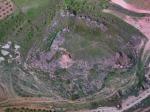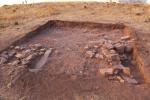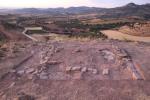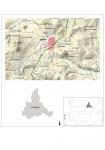Summary (English)
“Cerro del Calvario” is a Roman Republican mining-metallurgical settlement located in the municipal term of Tabuenca (Spain). The site is on a hill at 819 meters above sea-level, and about 600 meters from Tabuenca municipality centre, on its southwest side. Access is via Tabuenca along the street “Tiro Bola” following the paved path from Tabuenca to Épila to the base of the hill where the settlement and the catholic hermitage that gives it its name are located. The first known works are the excavations carried out by the forensic doctor Pedro de Pablo Aparicio, a local scholar who performed a series of excavations on the hill in the 50’s and 60’s of the 20th century involving local youth.
Since the year 2016 an archaeological excavation project in the settlement and an archaeological prospecting project in the mining territory have been developed. These projects have allowed the identification of numerous pieces of iron slag and old mining works. The excavations are focused on two sectors, 1 and 2 respectively, in which walls and pavements have been located. The material culture documented in the settlement is mainly composed of Celtiberian ceramics and grey ceramics. Together with the building techniques and the modulation of the spaces which have already been excavated, they show a provisional chronology between the last third of the second century BC. and the first half of the first century BC.
Regarding the economic activities identified in the settlement, it is worth stressing the appearance of a large amount of carbonized grain in Sector 2 linked to storage and cooking pottery remains. In addition to this, steelmaking has been documented in all phases of the iron, with furnace slag present in Sector 1 and bleed slag in Sector 2 corresponding to the transformation process of the ore into metal in the furnace in both cases. Also in both sectors were found lupine refining slag and ultimately flat-convex slabs or forge cakes corresponding to the work process in the forge with anvil and hammer, showing that the main economic activity in the settlement was the metallurgical exploitation of iron in antiquity.
- Óscar Bonilla Santander y Begoña Serrano Arnáez
Director
- Begoña Serrano Arnáez (Universidad de Granada)
- Óscar Bonilla Santander (Universidad de Zaragoza)
Team
- María del Cármen Román Muñoz
- Alicia María Izquierdo
- Carlos Valladares Lafuente
- Ángel Santos Horneros
- Miriam Pérez Aranda
- Museo de Zaragoza
Research Body
- Asociación de Investigadores del Moncayo
- Universidad de Granada
- Universidad de Zaragoza
Funding Body
- Asociación Cultural Villardajos
- Asociación de Investigadores del Moncayo
- Ayuntamiento de Tabuenca






![Download [PDF]](/excavation/skins/fasti/images/results/download_sml.png)


